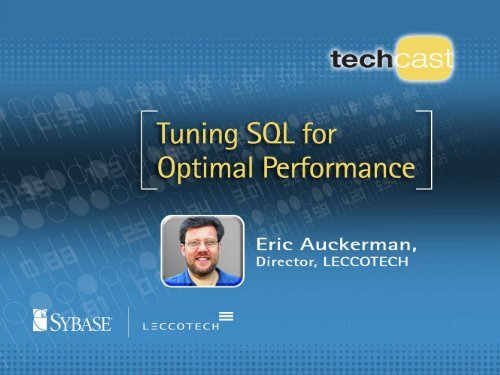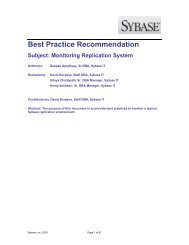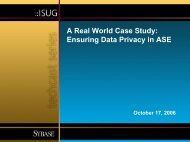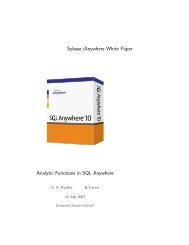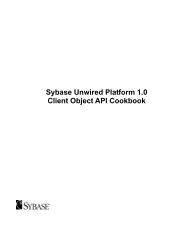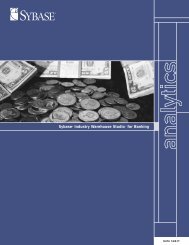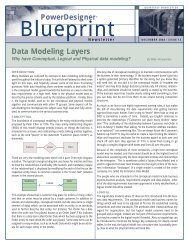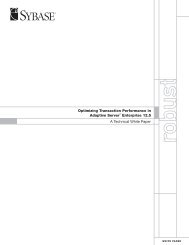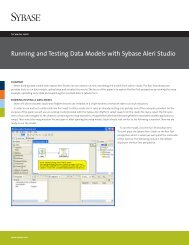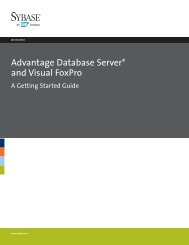Tuning SQL for Optimal Performance - Sybase
Tuning SQL for Optimal Performance - Sybase
Tuning SQL for Optimal Performance - Sybase
Create successful ePaper yourself
Turn your PDF publications into a flip-book with our unique Google optimized e-Paper software.
Agenda<br />
• What affects application<br />
per<strong>for</strong>mance<br />
• <strong>SQL</strong> Optimization and the<br />
Application Lifecycle<br />
• How to achieve and maintain<br />
maximum per<strong>for</strong>mance<br />
• Interview with Michael<br />
Brundige, Sr. <strong>Sybase</strong> DBA<br />
of Brinks
Gartner Study<br />
• According to industry experts,<br />
60% to 90% of database<br />
application per<strong>for</strong>mance<br />
problems are caused by <strong>SQL</strong><br />
<strong>SQL</strong><br />
Related<br />
60%<br />
“Poorly written OLTP application <strong>SQL</strong> continues to be the<br />
largest contributor to poor database per<strong>for</strong>mance.”<br />
Other<br />
40%<br />
– Gartner Group
A Corporate Per<strong>for</strong>mance Strategy<br />
• Hardware Upgrades 0 — 25%<br />
• Operating System Settings 0 — 50%<br />
• Database Server Parameter Settings 0 — 100%<br />
• Database Design 0 — 1000%<br />
• Indexes on Database Tables 0 — 1000%<br />
• <strong>SQL</strong> Statements 0 — 100,000%<br />
Based on LECCOTECH customer feedback
Sample of Customer Results<br />
Fremont Compensation – resource consumption<br />
Original statement: 2.5 hours <strong>SQL</strong> Expert optimized result: 1.5 minutes<br />
Original statement: 4 hours <strong>SQL</strong> Expert optimized result: 1.3 minutes<br />
Original statement: 8 hours <strong>SQL</strong> Expert optimized result: 2 hours<br />
Metasolv, Plano, TX – productivity<br />
Original statement: 15 minutes <strong>SQL</strong> Expert optimized result: 3 seconds<br />
Kentucky Community Technical Colleges – skill set<br />
Original statement: 1.2 hours <strong>SQL</strong> Expert optimized result: 15 seconds<br />
(complex statement with 8 table joins)
<strong>Sybase</strong> <strong>SQL</strong> Expert: A Per<strong>for</strong>mance Assurance Strategy<br />
Enhancements or<br />
New Requirements<br />
Maintain<br />
<strong>Optimal</strong><br />
Per<strong>for</strong>mance<br />
The Application Life-Cycle<br />
Development<br />
Production<br />
QA & Stress<br />
Best<br />
Per<strong>for</strong>ming<br />
Code<br />
Maximum<br />
Per<strong>for</strong>mance<br />
Be<strong>for</strong>e Rollout
3-Golden Rules <strong>for</strong> Writing <strong>SQL</strong><br />
• Make it work<br />
• Make it work right<br />
• Make it work fast
The Complex Nature of <strong>SQL</strong><br />
• Difficult to write <strong>SQL</strong> <strong>for</strong> per<strong>for</strong>mance<br />
• Many ways to write a <strong>SQL</strong><br />
• Small differences in coding <strong>SQL</strong> can have great per<strong>for</strong>mance<br />
implications<br />
• Need constant tuning due to data and system environment<br />
changes<br />
• Most important factor to system scalability
How to Tune <strong>SQL</strong><br />
• Understand how the database processes <strong>SQL</strong> statements<br />
• Know database structure<br />
• Know data in the database<br />
• Different <strong>SQL</strong> syntax can change per<strong>for</strong>mance
How Does ASE Process <strong>SQL</strong>?<br />
Data<br />
<strong>SQL</strong><br />
Server Receives <strong>SQL</strong><br />
Parse, Normalize &<br />
Pre-Process<br />
ASE Optimizer<br />
Determines the Query Plan<br />
Bind<br />
Execute
How the ASE Optimizer Works*<br />
<strong>SQL</strong><br />
Internally<br />
Rewrites &<br />
Generates<br />
Multiple<br />
Query plans<br />
Plan 1 cost=1000<br />
Plan 2 cost=3000<br />
Plan 3 cost=500<br />
Plan 1<br />
Plan 2<br />
Plan 3<br />
Cost Estimation
How the ASE Optimizer Works*<br />
<strong>SQL</strong><br />
Internally<br />
Rewrites &<br />
Generates<br />
Multiple<br />
Query plans<br />
Plan 1 cost=1000<br />
Plan 2 cost=3000<br />
Plan 3 cost=500<br />
Plan 1<br />
Plan 2<br />
Plan 3<br />
Can it try every possible<br />
way to rewrite your <strong>SQL</strong>?<br />
Cost Estimation
How the ASE Optimizer Works*<br />
<strong>SQL</strong><br />
Internally<br />
Rewrites &<br />
Generates<br />
Multiple<br />
Query plans<br />
Plan 1 cost=1000<br />
Plan 2 cost=3000<br />
Plan 3 cost=500<br />
Plan 1<br />
Plan 2<br />
Plan 3<br />
Can it try every possible<br />
way to rewrite your <strong>SQL</strong>?<br />
Cost Estimation<br />
How Accurate is the<br />
Cost Estimation<br />
Execution
The Perfect Optimizer?<br />
“For any real-life optimizer, no matter how sophisticated, there will<br />
always be a query, a database state and a system state where the<br />
optimizer makes the wrong decision.”<br />
Mihnea Andrei (<strong>Sybase</strong> France) &<br />
Patrick Valduriez (Laboratoire d’In<strong>for</strong>matique de Paris)<br />
User-Optimizer Communication, Abstract Plans Tech paper
2 Different <strong>SQL</strong>’s – Same Query Plan<br />
Elapsed Time: 0.080 s Elapsed Time: 0.080 s
2 Different <strong>SQL</strong>’s – 2 Different Plans<br />
Elapsed Time: 0.080 s Elapsed Time: 0.110 s
Find the Best Way to Process Your <strong>SQL</strong>
Find the Best Way to Process Your <strong>SQL</strong>
Manual Approach – <strong>SQL</strong> <strong>Tuning</strong><br />
• Obtain show_plan and analyze output. Look <strong>for</strong> problem<br />
operations such as full table scans<br />
i<strong>SQL</strong><br />
SET SHOWPLAN ON<br />
GO<br />
SELECT *<br />
FROM EMPLOYEE<br />
WHERE EM P_ID > 73712<br />
GO<br />
SET SHOWPLAN OFF<br />
GO<br />
QUERY PLAN FOR STATEMENT 1 (at line 1).<br />
STEP 1<br />
The type of query is SELECT.<br />
FROM TABLE<br />
EMPLOYEE<br />
Nested iteration.<br />
Table Scan.<br />
Forward scan.<br />
Positioning at start of table.<br />
Using I/O Size 2 Kbytes <strong>for</strong> data pages.<br />
With LRU Buffer Replacement Strategy <strong>for</strong> data pages.<br />
Total estimated I/O cost <strong>for</strong> statement 1 (at line 1): 20600.
Manual Approach – <strong>SQL</strong> <strong>Tuning</strong><br />
• Try different ways to write the <strong>SQL</strong> statement<br />
• Techniques to write <strong>SQL</strong>:<br />
– IN, EXISTS, or JOIN<br />
– Full table scan, or index scan<br />
– JOIN access path<br />
– NOT IN, or MINUS<br />
– Outer Join, or UNION ALL<br />
– IN or OR<br />
– Forces?<br />
– Temp tables?<br />
– ….
Article – Fifty Ways to Quote Your Query<br />
BY C. J. Date, July 1998<br />
Database Programming & Design<br />
1. SELECT DISTINCT S.SNAME<br />
FROM S, SP<br />
WHERE S.S# = SP.S#<br />
AND SP.P# = 'P2'<br />
“if there are so many ways to<br />
<strong>for</strong>mulate such a simple query,<br />
how many ways are there going<br />
to be <strong>for</strong> a complicated one?”<br />
2. SELECT DISTINCT S.SNAME<br />
FROM S<br />
WHERE S.S# IN<br />
( SELECT SP.S#<br />
FROM SP<br />
WHERE SP.P# = 'P2' )<br />
3. SELECT DISTINCT S.SNAME<br />
FROM S<br />
WHERE S.S# =ANY<br />
( SELECT SP.S#<br />
FROM SP<br />
WHERE SP.P# = 'P2' )<br />
4. SELECT DISTINCT S.SNAME<br />
FROM S<br />
WHERE S.S# MATCH<br />
( SELECT SP.S#<br />
FROM SP<br />
WHERE SP.P# = 'P2' )<br />
5. SELECT DISTINCT S.SNAME<br />
FROM S<br />
WHERE S.S# MATCH<br />
UNIQUE<br />
( SELECT SP.S#<br />
FROM SP<br />
WHERE SP.P# = 'P2' )<br />
6. SELECT DISTINCT S.SNAME<br />
FROM S<br />
WHERE S.S# MATCH<br />
PARTIAL<br />
( SELECT SP.S#<br />
FROM SP<br />
WHERE SP.P# = 'P2' )
Manual Approach – <strong>SQL</strong> <strong>Tuning</strong><br />
• Time the alternatives in I<strong>SQL</strong><br />
i<strong>SQL</strong><br />
SET STATISTICS IO ON<br />
GO<br />
SET STATISTICS TIME ON<br />
GO<br />
SELECT *<br />
FROM EMPLOYEE<br />
WHERE EMP_ID > 73712<br />
GO<br />
SET STATISTICS IO OFF<br />
GO<br />
SET STATISTICS TIME OFF<br />
GO<br />
Server Message: Number 3631, Severity 10<br />
Line 1:<br />
Total actual I/O cost <strong>for</strong> this command: 0.<br />
Total writes <strong>for</strong> this command: 0<br />
Server Message: Number 3631, Severity 10<br />
Line 1:<br />
Total actual I/O cost <strong>for</strong> this command: 0.<br />
Total writes <strong>for</strong> this command: 0<br />
Execution Time 0.<br />
<strong>SQL</strong> Server cpu time: 0 ms. <strong>SQL</strong> Server elapsed time: 3614 ms.<br />
Parse and Compile Time 0.<br />
<strong>SQL</strong> Server cpu time: 0 ms.<br />
Table: EMPLOYEE scan count 1, logical reads: (regular=1030 apf=0 total=1030),<br />
physical reads: (regular=0 apf=0 total=0), apf IOs used=0<br />
Server Message: Number 3631, Severity 10<br />
Line 1:<br />
Total actual I/O cost <strong>for</strong> this command: 2060.<br />
Total writes <strong>for</strong> this command: 0<br />
Execution Time 16.<br />
<strong>SQL</strong> Server cpu time: 1600 ms. <strong>SQL</strong> Server elapsed time: 7730 ms.<br />
(18371 rows affected)<br />
Parse and Compile Time 0.<br />
<strong>SQL</strong> Server cpu time: 0 ms.<br />
Execution Time 0.<br />
<strong>SQL</strong> Server cpu time: 0 ms. <strong>SQL</strong> Server elapsed time: 0 ms.<br />
Parse and Compile Time 0.<br />
<strong>SQL</strong> Server cpu time: 0 ms.
<strong>SQL</strong> Expert<br />
• Streamlines the <strong>SQL</strong> optimization process<br />
• Proactively identifies problematic <strong>SQL</strong> without running applications<br />
• AI-based <strong>SQL</strong> trans<strong>for</strong>mation generates every possible alternative<br />
and unique query plan<br />
• Benchmarks <strong>SQL</strong> to identify the most efficient alternative <strong>for</strong> a db<br />
environment<br />
• Provide the “OPTIMUM” <strong>SQL</strong> alternative
<strong>SQL</strong> Optimization Methodology<br />
Capture/Extract<br />
Analyze<br />
Maximize<br />
Per<strong>for</strong>mance<br />
Optimize
<strong>SQL</strong> Optimization Methodology<br />
Capture/Extract<br />
Analyze<br />
Maximize<br />
Per<strong>for</strong>mance<br />
• Dynamic <strong>SQL</strong>:<br />
Captures <strong>SQL</strong> through<br />
the <strong>Sybase</strong> Monitor<br />
Server<br />
— <strong>SQL</strong> Monitor<br />
Optimize<br />
• Embedded <strong>SQL</strong>:<br />
Extracts <strong>SQL</strong> from ASE<br />
database objects (sp’s,<br />
views, etc), files,<br />
source code<br />
(PowerBuilder, etc)<br />
— <strong>SQL</strong> Scanner
<strong>SQL</strong> Monitor – Capture currently running <strong>SQL</strong>
<strong>SQL</strong> Scanner – Extract embedded <strong>SQL</strong> from db objects & source code
<strong>SQL</strong> Optimization Methodology<br />
Capture/Extract<br />
Analyze<br />
• Analyze in batch the query plan <strong>for</strong> multiple <strong>SQL</strong><br />
• Identify potentially problematic operations: Full<br />
tables scans-large tables, many table scans,<br />
worktables,…<br />
—<strong>SQL</strong> Scanner<br />
Maximize<br />
Per<strong>for</strong>mance<br />
Optimize
<strong>SQL</strong> Scanner – Analyze and identify problematic query plans
Problematic <strong>SQL</strong> identified, without running it!
<strong>SQL</strong> Optimization Methodology<br />
• AI based recursive <strong>SQL</strong><br />
trans<strong>for</strong>mation<br />
• Provides unique query<br />
plans<br />
• Guarantees semantically<br />
equivalence<br />
• •Capture/Extract Rewrites SELECT,<br />
SELECT…INTO,<br />
INSERT, DELETE and<br />
UPDATE<br />
• Benchmarks test <strong>SQL</strong><br />
—Syntactical <strong>SQL</strong> Optimizer<br />
Analyze<br />
Maximize<br />
Per<strong>for</strong>mance<br />
Optimize
What is Recursive <strong>SQL</strong> Trans<strong>for</strong>mation<br />
Using 2 trans<strong>for</strong>mation rules<br />
SELECT * FROM A<br />
WHERE EXISTS (SELECT ‘x’ FROM B<br />
WHERE EXISTS (SELECT ‘x’ FROM C<br />
WHERE B.C2=C.C2)<br />
WHERE A.C1=B.C1)<br />
IN to<br />
EXISTS<br />
SELECT * FROM A<br />
WHERE A.C1 IN (SELECT B.C1 FROM B<br />
WHERE EXISTS (SELECT ‘x’ FROM C<br />
WHERE B.C2=C.C2 ))<br />
EXISTS<br />
to IN<br />
SELECT * FROM A<br />
WHERE A.C1 IN (SELECT B.C1 FROM B<br />
WHERE B.C2 IN<br />
(SELECT C.C2 FROM C))<br />
EXISTS<br />
to IN<br />
IN to<br />
EXISTS<br />
SELECT * FROM A<br />
WHERE A.C1 IN (SELECT B.C1 FROM B<br />
WHERE EXISTS (SELECT ‘x’ FROM C<br />
WHERE B.C2=C.C2 ))<br />
SELECT * FROM A<br />
WHERE EXISTS (SELECT ‘x’ FROM B<br />
WHERE B.C2 IN (SELECT C.C2 FROM C)<br />
AND A.C1=B.C1)<br />
SELECT * FROM A<br />
WHERE A.C1 IN (SELECT B.C1 FROM B<br />
WHERE B.C2 IN (SELECT C.C2 FROM C))<br />
SELECT * FROM A<br />
WHERE EXISTS (SELECT ‘x’ FROM B<br />
WHERE B.C2 IN (SELECT C.C2 FROM C)<br />
AND A.C1=B.C1)<br />
SELECT * FROM A<br />
WHERE A.C1 IN (SELECT B.C1 FROM B<br />
WHERE EXISTS (SELECT ‘x’ FROM C<br />
WHERE B.C2=C.C2))<br />
SELECT * FROM A<br />
WHERE EXISTS (SELECT ‘x’ FROM B<br />
WHERE EXISTS (SELECT ‘x’ FROM C<br />
WHERE B.C2=C.C2)<br />
AND A.C1=B.C1)
<strong>SQL</strong> Optimization – In 2 minutes, <strong>SQL</strong> Expert generated 279 alternatives
Benchmark testing the <strong>SQL</strong> alternatives against the database –<br />
Locate the most–efficient <strong>SQL</strong> <strong>for</strong> the ASE environment
Original <strong>SQL</strong><br />
Elapsed Time: 0.763 s<br />
Fastest <strong>SQL</strong> Alternative<br />
Elapsed time: 0.060 s
Polling Question<br />
Yes or No<br />
Have you used ASE’s<br />
Abstract Plans?
Abstract Plan<br />
<strong>SQL</strong><br />
Optimizer<br />
ASE<br />
Based on the<br />
database statistics<br />
to generate a query<br />
plan<br />
Based on the saved<br />
abstract plan to<br />
generate a query<br />
plan<br />
Execution
<strong>Sybase</strong> <strong>SQL</strong> Expert Facts<br />
• <strong>Sybase</strong> <strong>SQL</strong> Expert (SSE) is sold as an option to ASE<br />
• Windows-based product, Client-based product, no server-side<br />
installation<br />
• Databases supported:<br />
– From version 11.0 to ASE 12.5.0.3<br />
– To capture <strong>SQL</strong> from the <strong>Sybase</strong> Monitor Server, ASE 11.5 or above required<br />
– To use Abstract Plans, ASE 12.0 or above required<br />
• Open Client/CT-Lib version 11 or above<br />
• <strong>Sybase</strong> Monitor Server is only needed to capture currently running<br />
<strong>SQL</strong>; you can use <strong>SQL</strong> Expert without the <strong>Sybase</strong> Monitor Server<br />
• Non-intrusive<br />
– Scanning and optimization process occurs in the PC; no over-head to the<br />
database
Key <strong>SQL</strong> Expert Benefits<br />
• Automates current manual tuning ef<strong>for</strong>ts<br />
• Solves the problem consuming 60–90% of IT resources<br />
• Delivers immediate and quantifiable application<br />
per<strong>for</strong>mance gains<br />
• Heightens staff expertise<br />
• Increases staff productivity<br />
• Establishes benchmarks and per<strong>for</strong>mance standards<br />
Use <strong>Sybase</strong> <strong>SQL</strong> Expert to ensure only<br />
the best per<strong>for</strong>ming statements are used.
Interview with Michael<br />
Brundige, Sr. <strong>Sybase</strong><br />
DBA of Brinks


